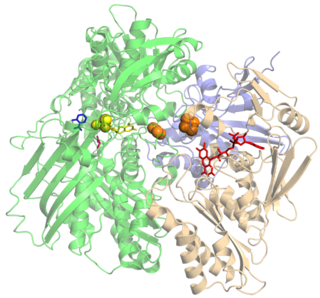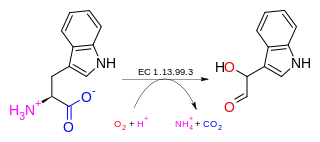A dehydrogenase is an enzyme belonging to the group of oxidoreductases that oxidizes a substrate by reducing an electron acceptor, usually NAD+/NADP+ or a flavin coenzyme such as FAD or FMN. Like all catalysts, they catalyze reverse as well as forward reactions, and in some cases this has physiological significance: for example, alcohol dehydrogenase catalyzes the oxidation of ethanol to acetaldehyde in animals, but in yeast it catalyzes the production of ethanol from acetaldehyde.

Xanthine oxidase is a form of xanthine oxidoreductase, a type of enzyme that generates reactive oxygen species. These enzymes catalyze the oxidation of hypoxanthine to xanthine and can further catalyze the oxidation of xanthine to uric acid. These enzymes play an important role in the catabolism of purines in some species, including humans.

Glucobrassicin is a type of glucosinolate that can be found in almost all cruciferous plants, such as cabbages, broccoli, mustards, and woad. As for other glucosinolates, degradation by the enzyme myrosinase is expected to produce an isothiocyanate, indol-3-ylmethylisothiocyanate. However, this specific isothiocyanate is expected to be highly unstable, and has indeed never been detected. The observed hydrolysis products when isolated glucobrassicin is degraded by myrosinase are indole-3-carbinol and thiocyanate ion, which are envisioned to result from a rapid reaction of the unstable isothiocyanate with water. However, a large number of other reaction products are known, and indole-3-carbinol is not the dominant degradation product when glucosinolate degradation takes place in crushed plant tissue or in intact plants.
In enzymology, a xanthoxin dehydrogenase (EC 1.1.1.288) is an enzyme that catalyzes the chemical reaction
In enzymology, an indole-3-acetaldehyde reductase (NADH) (EC 1.1.1.190) is an enzyme that catalyzes the chemical reaction
In enzymology, an indole-3-acetaldehyde reductase (NADPH) (EC 1.1.1.191) is an enzyme that catalyzes the chemical reaction
Long-chain alcohol oxidase is one of two enzyme classes that oxidize long-chain or fatty alcohols to aldehydes. It has been found in certain Candida yeast, where it participates in omega oxidation of fatty acids to produce acyl-CoA for energy or industrial use, as well as in other fungi, plants, and bacteria.
In enzymology, an abscisic-aldehyde oxidase (EC 1.2.3.14) is an enzyme that catalyzes the chemical reaction
In enzymology, an indole 2,3-dioxygenase (EC 1.13.11.17) is an enzyme that catalyzes the chemical reaction

In enzymology, a tryptophan 2'-dioxygenase is an enzyme that catalyzes the chemical reaction
In enzymology, a tryptophan 2-monooxygenase (EC 1.13.12.3) is an enzyme that catalyzes the chemical reaction
The enzyme indole-3-glycerol-phosphate lyase catalyzes the chemical reaction

Tryptophol is an aromatic alcohol that induces sleep in humans. It is found in wine as a secondary product of ethanol fermentation. It was first described by Felix Ehrlich in 1912. It is also produced by the trypanosomal parasite in sleeping sickness.
7-Chloro-L-tryptophan oxidase (EC 1.4.3.23, RebO) is an enzyme with systematic name 7-chloro-L-tryptophan:oxygen oxidoreductase. This enzyme catalyses the following chemical reaction
Spermine oxidase (EC 1.5.3.16, PAOh1/SMO, AtPAO1, AtPAO4, SMO) is an enzyme with systematic name spermidine:oxygen oxidoreductase (spermidine-forming). This enzyme catalyses the following chemical reaction
Non-specific polyamine oxidase (EC 1.5.3.17, polyamine oxidase, Fms1, AtPAO3) is an enzyme with systematic name polyamine:oxygen oxidoreductase (3-aminopropanal or 3-acetamidopropanal-forming). This enzyme catalyses the following chemical reaction
Tryptophan N-monooxygenase (EC 1.14.13.125, tryptophan N-hydroxylase, CYP79B1, CYP79B2, CYP79B3) is an enzyme with systematic name L-tryptophan,NADPH:oxygen oxidoreductase (N-hydroxylating). This enzyme catalyses the following chemical reaction
Indole-3-pyruvate monooxygenase (EC 1.14.13.168, YUC2 (gene), spi1 (gene)) is an enzyme with systematic name indole-3-pyruvate,NADPH:oxygen oxidoreductase (1-hydroxylating, decarboxylating). This enzyme catalyses the following chemical reaction

Abscisic aldehyde is an intermediate in the biosynthesis of the plant hormone abscisic acid. It is produced by the dehydrogenation of xanthoxin by xanthoxin dehydrogenases, which is an NAD+ dependent short-chain dehydrogenase, followed by selective oxidation by abscisic aldehyde oxygenase.

Camalexin (3-thiazol-2-yl-indole) is a simple indole alkaloid found in the plant Arabidopsis thaliana and other crucifers. The secondary metabolite functions as a phytoalexin to deter bacterial and fungal pathogens.






